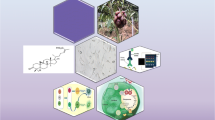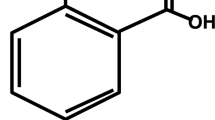Abstract
25-Hydroxy-3-oxoolean-12-en-28-oic acid (Amooranin-AMR) is a triterpene acid isolated from the stem bark of a tropical tree (Amoora rohituka) grown wild in India. A herbal preparation used for the treatment of cancer by the Ayurvedic system of medicine contains the stem bark of Amoora rohituka as one of the ingredients. In this paper, we show that AMR displays a strong inhibitory effect on survival of human breast carcinoma MDA-468, breast adenocarcinoma MCF-7 cells compared to breast epithelial MCF-10A control cells. A 50% decrease in cells (IC50) ranged from 1.8 to 14.6 µM and cell growth was suppressed by arresting cell cycle at G2 + M phase. AMR effectively induces apoptosis and triggered a series of effects associated with apoptosis including cleavage of caspase-8, -9, -3, Bid and ER stress in MDA-468 cells and caspase- 8, -9, -6 and Bid in MCF-7 cells, release of cytochrome c from the mitochondria, cleavage of poly (ADP-ribose) polymerase (PARP) and DNA fragmentation with a concomitant upregulation of p53, Bax and down-regulation of Bcl-2 in MDA-468 cells, but Bax unchanged in MCF-7 cells. The use of caspase blocking peptides and acridine orange staining confirmed the involvement of primarily caspase-9 and -3 in MDA-468 cells with mutated p53 and primarily caspase-8, -9 and -6 in MCF-7 cells expressing wt p53. We also observed in MCF-7/p53siRNA cells AMR treatment caused reduced expression of Bcl-2 without affecting levels of Bax similar to MCF-7 cells treated with AMR and proteolytic activation of Bax in MDA-468 cells. These results suggest that AMR induces apoptosis in human breast carcinoma cells via caspase activation pathway and likely it is a p53-independent apoptosis.
Similar content being viewed by others
References
American Cancer Scociety. Cancer Statistics, 2005
Kim KB, Lotan R, Yue P, Sporn MB, Suh N, Gribble GW, Honda T, Wu GS, Hong W, Sun SY (2002) Identification of a novel synthetic triterpenoid, methyl-2-cyano-3, 12-dioxooleane-1,9-dien-28-oate, that potently induces caspase-mediated apoptosis in human lung cancer cells. Mol Cancer Ther 1:177–184
Rabi T (1986) Antitumor activity of amooranin from Amoora rohituka stem bark. Curr Sci 70:80–81
Prasad GC (1987) Studies on cancer in Ayurveda and its management. J Res Ayurveda Sidha 8:147–167
Rabi T, Ramachandran C, Fonseca HB, Alamo A, Melnick SJ, Escalon E (2003) Amooranin, a novel drug, induces apoptosis through caspase activity in human breast carcinoma cell lines. Breast Cancer Res Treat 80:321–330
Ramachandran C, Rabi T, Fonseca HB, Melnick SJ, Escalaon EA (2003) Novel plant triterpenoid drug amooranin overcomes multidrug resistance in human leukemia and colon carcinoma cell lines. Int J Cancer 105:784–789
Rabi T, Karunagaran D, Krishnan Nair M, Bhattathiri VN (2002) Cytotoxic activity of amooranin and its derivatives. Phytother Res 16:S84–86
Li P, Nijhawan D, Budihardjo I, Srinivasulu SM, Ahmad M, Alnemri ES, Wang X (1997) Cytochrome c and dATP-dependent formation of Apaf-1/caspase-9 complex initiates an apoptotic protease cascade. Cell 91:479–489
Srinivasulu SM, Ahmad M, Fernandes-Alnemri T, Alnemri ES (1998) Autoactivation of procaspase-9 by Apaf-1 mediated oligomerization. Mol Cell 1:949–957
Li H, Zhu X, Xu CJ, Yuan J (1998) Cleavage of Bid by caspase-8 mediates the mitochondrial damage in the Fas pathway of apoptosis. Cell 94:491–501
Luo X, Budihardjo I, Zou H, Slaughter C, Wang I (1998) Bid, a Bcl-2 interacting protein, mediates cytochrome c release from mytochondria in response to activation of cell surface death receptors. Cell 94:481–490
Tsujimoto Y, Shimizu (2000) Bcl-2 family: life-or-death switch. FEBS Lett 466:6–10
Scaffidi C, Fulda S, Srinivasan A, Friesen C, Li F, Tomaselli KJ, Debatin KM, Krammer PH, Peter ME (1998) Two CD 95 (APO/Fas) signaling pathways. EMBO J 17:1675–1687
Fribley A, Zeng Q, Wang CY (2004) Proteasome inhibitor PS-341 induces apoptosis through induction of endoplasmic reticulum stress reactive oxygen species in head and neck squamous cell carcinoma cells. Mol Cell Biol 24:9695–9704
Hansen MB, Nielsen SE, Berg K (1989) Re-examination and further development of a precise and rapid dye method for measuring cell growth/cell kill. J Immunol Meth 119:203–210
Rudner AD, Murray AW (1996) The spindle assembly checkpoint. Curr Opin Cell Biol 8:773–780
Cohen JJ, Duke RC (1984) Glucocorticoid activation of a calcium dependent endonuclease in thymocyte nucleic leads to cell death. J Immunol 132:38–42
Prasad KA, Church JG (1997) Characterization of DNA binding and transcriptional regulatory function of an endogenous mutant p53 in MDA-468 human breast cancer cells. Biochem Biophys Res Commun 232:14–19
Robinson BW, Schewach DS (2001) Radiosensitization by Gemcitabine in p53 wild-type and mutant MCF-7 breast carcinoma cell lines. Clin Cancer Res 7:2581–2589
Dumaz N, Meek DW (1999) Serine 15 phosphorylation stimulates p53 transactivation but does not directly influence interaction with HDM2. EMBO J 18:7002–10
Tweddle DA, Malcolm AJ, Bown N, Pearson AD, Lunec J (2001) Evidence for the development of p53 mutations after cytotoxic therapy in a neurobalstoma cell line. Cancer Res 61:8–13
Janicke RU, Ng P, Sprengart MI, Porter AG (1998a) Caspase-3 is required for fodrin cleavage but dispensible for cleavage of other death substrates in apoptosis. J Biol Chem 273:15540–15545
Rabi T, Gupta RC (1995) Antitumor and cytotoxic investigation of Amoora rohituka. Int J Pharmacogn 33:359–361
Weinert TA, Hartwell LH (1990) Characterization of RAD9 of Saccharomyces cerevisiae and evidence that its function acts posttranslationary in cell cycle arrest after DNA damage. Mol Cell Biol 10:6554–6564
O’Connor PM, Ferris DK, Pagano M, Draetta G, Pines J, Hunter T, Longo DL, Kohn KW (1993) G2 delay induced by nitrogen mustard in human cells affects cyclin A/cdk2, and cyclin B1/cdc2-kinase complexes differently. J Biol Chem 268:8298–8303
Lowe SW, Schmitt EM, Smith SW, Osborne BA, Jacks T (1993) p53 is required for radiation-induced apoptosis in mouse thymocytes. Nature 362:847–849
Mehmet H (2002) Apoptosis: caspase find a new place to hide. Nature 403:29–30
Hengartner MO (2000) The biochemistry of apoptosis. Nature 407:770–776
Weller M (1998) Predicting response to cancer chemotherapy: the role of p53. Cell Tissue Res 292:443–448
Ferreira CG, Tolis C, Giaccone G (1999) p53 and chemosensitivity. Ann Oncol 10:1011–1021
Tang D, Kidd VJ (1998) Cleavage of DFF-45/ICAD by multiple caspases is essential for its function during apoptosis. J Biol Chem 273:28549–28552
Zapata JM, Krajewski S, Huang R, Takayama S, Wang H, Adamson E, Reed JC (1998) Expression of multiple apoptosis regulatory genes in human breast cancer cell lines and primary tumors. Breast Cancer Res Treat 47:129–140
Zheng TS, Hunot S, Kuida K, Momoi T, Srinivasan A, Nicholson DW, Lazebnik Y, Flavell RA (2000) Deficiency in caspase-9 or caspase-3 induces compensatory caspase activation. Nat Med 6:1241–1247
Wolf BB, Schuler M, Echeverri F, Green DR (1999) Caspase-3 is the primary activator of apoptotic DNA fragmentation factor-45/Inhibitor of caspase-activated DNase inactivation. J Biol Chem 274:30651–30656
Decker P, Isenberg D, Muller S (2000) Inhibition of caspase-3 mediated poly (ADP-ribose) polymerase (PARP) apoptotic cleavage by human PARP autoantibodies and effect on cells undergoing apoptosis. J Biol Chem 275:9043–9046
Sellers WR, Fisher DE (1999) Apoptosis and cancer drug targeting. J Clin Invest 104:1655–1661
Roth W, Reed JC (2002) Apoptosis and cancer. When BAX is TRAILing away. Nat Med 8:216–218
Ashkenazi A, Dixit VM (1998) Death receptors: signaling and modulation. Science 281:1305–1308
Adams JM, Cory S (1998) The bcl-2 protein family: arbiters of cell survival. Science 281:1322–1326
Oltvai ZN, Milliman CL, Korsmeyer SJ (1993) Bcl-2 heterodimerizes in vivo with a conserved homolog, Bax, that accelerates programmed cell death. Cell 74:609–615
Zinszner H, Kuroda M, Wang X, Batchvarova N, Light-foot RT, Remotti H, Stevens JL, Ron D (1998) CHOP is implicated in programmed cell death in response to impaired function of the endoplasmic reticulum. Genes Dev 12:982–995
McCullough KD, Martindale JL, Klotz LO, Aw TY, Holbrook NJ (2001) Gadd153 sensitizes cells to endoplasmic reticulum stress by down-regulating Bcl-2 and perturbing the cellular redox state. Mol Cell Biol 21:1249–1259
Hitomi J, Katayama T, Eguchi Y (2004) Involvement of caspase-4 in endoplasmic reticulum stress-induced apoptosis and Aβ-induced cell death. J Cell Biol 165:347–356
Acknowledgements
This work was supported by the NCI/NIH, MD, USA through Oncology Research Faculty Development Program.
Author information
Authors and Affiliations
Corresponding author
Rights and permissions
About this article
Cite this article
Rabi, T., Wang, L. & Banerjee, S. Novel triterpenoid 25-hydroxy-3-oxoolean-12-en-28-oic acid induces growth arrest and apoptosis in breast cancer cells. Breast Cancer Res Treat 101, 27–36 (2007). https://doi.org/10.1007/s10549-006-9275-z
Published:
Issue Date:
DOI: https://doi.org/10.1007/s10549-006-9275-z




